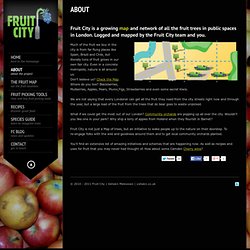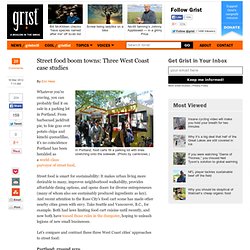

Urban Farming. Earth to Portlandia: Backyard Goats and Chickens Filling Up Animal Sanctuaries. When does backyard gardening turn into backyard farming?

Around the time when well-meaning folks decide to supplement their vegetable patch with some laying hens, or else maybe some chickens or a goat or two. Though that kind of arrangement undoubtedly works well for some, others are finding that their urban or suburban locale doesn’t make for very convenient animal husbandry. According to a recent piece in E – The Environmental Magazine, that’s resulted in a growing incidence of animal abandonment, with sanctuaries from Upstate New York to Oregon overburdened with chickens and goats. About « Fruit City. Much of the fruit we buy in the city is from far flung places like Spain, Brazil and Chile, but literally tons of fruit grows in our own fair city.

Even in a concrete metropolis, nature is all around us. Don’t believe us? Check the Map. Where do you live? Blackberries, Mulberries, Apples, Pears, Plums,Figs, Strawberries and even some secret Kiwis. We are not saying that every Londoner can get all the fruit they need from the city streets right now and through the year, but a large load of the fruit from the trees that do bear goes to waste unpicked.
What if we could get the most out of our London? Fruit City is not just a Map of trees, but an initiative to wake people up to the nature on their doorstep. You’ll find an extensive list of amazing initiatives and schemes that are happening now. The Union Street Urban Orchard. Forage Restaurant Opens. Inside the pantry, out in the yard, wearing a brown paper bag: Your next meal’s been playing hide and seek.

Game over. Forage is open. Find the sunny, white-walled, and wood-benched spot’s menu on the blackboard overhead. Nab brioche galettes and minicakes fresh out of the oven to pair with Blue Bottle Coffee, drip-brewed by the cup. Fill up on market-driven veggie sides from dilly beets to smashed roast potatoes or hearty plates of braised meatballs with grilled bread or avocado on a crusty baguette with cabbage, tomato, and fennel pickles (pork belly comes the same way). In line with his local and sustainable ways, chef Jason Kim (last seen as sous chef at Lucques) will take whatever’s growing in your garden (or on that one odd kumquat tree), fix it up, and add it to the offerings of the day. The kitchen’s currently looking for citrus fruits, if you’re holding.
Street food boom towns: Three West Coast case studies. In Portland, food carts fill a parking lot with lines stretching onto the sidewalk.

(Photo by camknows.) Whatever you’re craving, you can probably find it on sale in a parking lot in Portland. From barbecued jackfruit pie, to foie gras over potato chips and kimchi quesadillas, it’s no coincidence Portland has been heralded as a world-class purveyor of street food. Street food is smart for sustainability: It makes urban living more desirable to many, improves neighborhood walkability, provides affordable dining options, and opens doors for diverse entrepreneurs (many of whom also see sustainably produced ingredients as key).
And recent attention to the Rose City’s food cart scene has made other nearby cities green with envy. We Forage. Indoor farm in Brooklyn helps feed hundreds of families. In Bedford-Stuyvesant, an increasingly hip but historically low-income Brooklyn neighborhood, one food pantry is also an indoor farm.

The New York Daily News visited the Child Development Support Corporation, where every Thursday morning clients harvest lettuce, bok choy, and collard greens that help feed hundreds of families. Right now the greens are all grown hydroponically indoors, but the farm has plans to expand, adding a rooftop garden with cucumbers, tomatoes, and peppers. It will also be offering hydroponics workshops and cooking demos. The idea’s spreading to other social service agencies in the city, too. Providing basic fresh veggies isn’t too complicated; staffers simply hadn’t considered it before.
It was news to Los Sures pantry manager Robin Sirota that the windowless basement housing the South 3rd St. pantry was a suitable setting for growing salad greens. Turns out the two are not mutually exclusive. Growing Plants in the Dark. While sunlight contains all colors, the dominant type of chlorophyll in plants only needs purple light to function.

This simple fact has big implications for the future of farming. Crops planted in soil, of course, depend on the sun, while commercial greenhouses use white light to grow their crops. All that extra red, green and yellow energy is wasted on the plants. PlantLab has taken advantage of chlorophyll’s little quirk.